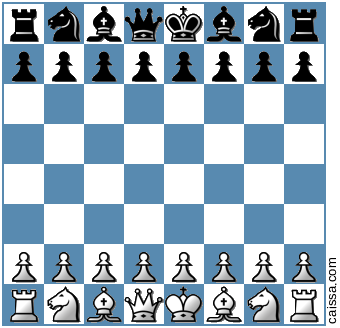|
|
Viewer |
|
|
|---|

| C77 Ruy Lopez |
| Spanish Game: Morphy Defense. Wormald Attack |
| Eric Schiller vs Mike Arne, 1995 |
| 1-0, 31 moves ("You and what Arne?") |
|
|
|
[Event "Training Tournament"] [Site "Foster City CA"] [Date "1995.??.??"] [EventDate "?"] [Round "?"] [Result "1-0"] [White "Eric Schiller"] [Black "Mike Arne"] [ECO "C77"] [WhiteElo "?"] [BlackElo "?"] [PlyCount "62"] 1.e4 {Notes by Eric Schiller. As I was finishing work on a book about Rudolph Spielmann, I took part in one of the regular all-Master training tournaments held monthly in the San Francisco area. I found myself paired with a very strong opponent, Mike Arne, 2400 FIDE. Since we were due to meet a few weeks later in an IM norm tournament, I decided that I shouldn't play my special preparation for him. Naturally with so much Spielmann on my mind I turned to one of his favorite lines, the Worral Attack in the Spanish Game. My preparation consisted solely of annotating a few games for that book, and the choice was made at the board. So this game shows that it is not necessary to study a lot of opening theory as White in the Spanish Game. All that is needed is some basic concepts, and either courage or recklessness!} e5 2.Nf3 Nc6 3.Bb5 a6 4.Ba4 Nf6 5.Qe2 b5 { 5...Be7 6.O-O O-O ? is a blunder: 7.Bxc6 dxc6 8.Nxe5 Qd4 9.Nf3 and if Qxe4 then 10.Qxe4 Nxe4 11.Re1 wins a piece. } 6.Bb3 Bc5 {The sharpest continuation. 6...Be7 7.c3 O-O 8.O-O d5 9.d3 Bb7 This is a popular and conservative defense, and has served Black well recently, for example in Ehlvest vs. Anand, Riga 1995. } 7.c3 {I was in no mood for quiet play with 7.d3, nor to face some of my own published analyis after 7. a4!} O-O 8.O-O {I could have settled for equality with 9.d3, but felt like taking a few chances.} d6 { 8...d5 9.exd5 [ 9.d3 is unclear, according to ECO. ] e4 10.Ng5 Bg4 11.Qe1 Ne5 12.d4 Nd3 13.Qe3 Bd6 14.Nxe4 Nxc1 15.Rxc1 Re8 16.f3 Bxh2+ 17.Kxh2 Bxf3 18.Qxf3 Nxe4 Black had a good game in Milev vs. Karaklajic, Belgrade 1957. } 9.h3 {This is prob ably not necessary, as Black's bishop is headed to b7, but I wanted to make sure it was kept off of g4, where the pin on the knight would weaken my control of d4.} Bb7 10.Rd1 Re8 11.a4 b4 12.a5 Qb8 {?! In retrospect, this is an error. The simple 12...Qe7 would have given Black an equal game.} 13.d4 {!? This is a deliberate sacrifice. I saw the Black forces huddled on the queenside and felt that a pawn could safely be invested for good attacking chances.} exd4 14.cxd4 Ba7 { 14...Rxe4 was certainly playable, but I felt that I would then have sufficient compensation. 15.Be3 !? Ba7 16.Nbd2 Re7 17.Qd3 White has g ood play for the pawn. Whether it is enough is not entirely clear, but as a practical matter I would have been satisfied with the position. } 15.e5 {!} d5 { 15...Nd7 16.Ng5 gives White a strong attack. 15...dxe5 16.dxe5 Nd8 17.Ng5 threatens Rxd8 followed by an assault at f7. 15...Re7 16.Bg5 Threatens to smash open the kingside. } 16.Qd3 {! Now Black must try for complications.} Ne4 { 16...Nd7 17.Bxd5 Ne7 18.Bc4 is simple and strong. } 17.Bxd5 Nxf2 {The idea is that if White captures the knight the pin the d4 allows captures at e5 with counterplay. Instead, I sacrifice a bishop and a rook to go after the undefended Black king.} 18.Bxf7+ {!! 18.Kxf2 Nxe5 19.Qb3 Bxd5 20.Qxd5 Nxf3 [ 20...c6 21.Qe4 Nxf3 22.Qxf3 Qd6 23.Be3 Re6 also provides a little counterplay. ] 21.gxf3 c5 leaves the White king vulnerable to attack. } Kxf7 19.Qf5+ Kg8 20.Ng5 Nxd1 { 20...Nxh3+ would have put up more resistance. 21.Qxh3 Bxd4+ 22.Rxd4 Nxd4 23.Qxh7+ Kf8 24.Qh8+ Ke7 25.Qxg7+ Kd8 26.Be3 Nf5 27.Qf6+ Ne7 28.Qe6 wins for White. } 21.Qxh7+ Kf8 22.Qh8+ Ke7 23.Qxg7+ Kd8 24.Nf7+ Kd7 {This position looks great for White, but it is not so simple.} 25.e6+ {! 25.Nd6+ Re7 26.Qg4+ Re6 and unfortunately the d-pawn, being pinned, cannot advance to d5. 25.Ng5+ Kc8 25.Bg5 Bxd4+ 26.Kh1 Nf2+ 27.Kh2 Ne7 } Kxe6 {Now there is a long series of forced moves.} 26.Ng5+ Kd5 27.Qd7+ {If the Black king is allowed to capture the d-pawn, then the next time it moves it will expose the White king to check from the bishop at a7, and that may, in some circumstances, give Black enough time to regroup.} Kc4 28.Nd2+ Kd3 29.Qf5+ {!} Kxd4 {Surely there is a mating net here! There is, but it involves a problem-like move.} 30.Ngf3+ {! 30.Ndf3+ Kc4+ would have prolonged the game. } Ke3 31.Kf1 {!! A quiet king move ends the spectacular combination. Black resigned.} 1-0 |
Game links and puns: www.chessgames.com
| | | zurück | | | | | Anfang | | | home | | |